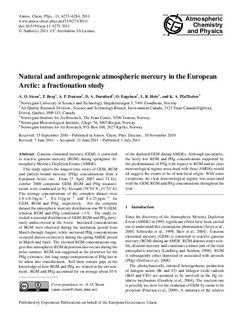| dc.description.abstract | This study reports the longest time series of GEM, RGM and particle-bound mercury (PHg) concentrations from a European Arctic site. From 27 April 2007 until 31 December 2008 composite GEM, RGM and PHg measurements were conducted in Ny-Ålesund (78° 54′ N, 11° 53′ E). The average concentrations of the complete dataset were 1.6 ± 0.3 ng m−3, 8 ± 13 pg m−3 and 8 ± 25 pg m−3 for GEM, RGM and PHg, respectively. For the complete dataset the atmospheric mercury distribution was 99 % GEM, whereas RGM and PHg constituted <1 %. The study revealed a seasonal distribution of GEM, RGM and PHg previously undiscovered in the Arctic. Increased concentrations of RGM were observed during the insolation period from March through August, while increased PHg concentrations occurred almost exclusively during the spring AMDE period in March and April. The elevated RGM concentrations suggest that atmospheric RGM deposition also occurs during the polar summer. RGM was suggested as the precursor for the PHg existence, but long range transportation of PHg has to be taken into consideration. Still there remain gaps in the knowledge of how RGM and PHg are related in the environment. RGM and PHg accounted for on average about 10 % of the depleted GEM during AMDEs. Although speculative, the fairly low RGM and PHg concentrations supported by the predominance of PHg with respect to RGM and no clear meteorological regime associated with these AMDEs would all suggest the events to be of non-local origin. With some exceptions, no clear meteorological regime was associated with the GEM, RGM and PHg concentrations throughout the year. | nb_NO |
